List of presidents of France facts for kids
The president of France is like the head leader of France. They are chosen by people voting every five years.
The first person considered a president was Louis-Napoléon Bonaparte. He was elected in 1848. But then, he took control in 1851 and later made himself emperor, known as Napoleon III. Many people supported him because he brought back the right for all men to vote, which had been taken away. This helped him start the Second Empire.
After Napoleon III's rule ended in 1870, France became a republic again, called the Third Republic. Later, in 1962, President Charles de Gaulle asked the people to vote on a new way to choose the president. Before this, presidents were chosen by a group of electors. After 1962, people started voting directly for their president. Since then, there have been ten presidential elections. The 25th and current president is Emmanuel Macron, who started his term on May 14, 2017.
Contents
Early Leaders of France
First Republic (1792–1804)
After the French Revolution, France became a republic. During this time, there wasn't one single president like today.
National Convention (1792–1795)
The National Convention was a group that led France. The person in charge, called the President of the National Convention, changed every two weeks. Important leaders during this time included Georges Danton and Maximilien Robespierre.
The Directory (1795–1799)
The Directory was a group of five leaders. They had a president, but this role was mostly for show and changed every three months. The real power was held by the group as a whole. Paul Barras was a very important figure during this period.
After a big change in government in 1799, called the Coup of 18 Brumaire, the Directory ended.
The Consulate (1799–1804)
After the Directory, France was led by three "Consuls." The most powerful of these was the First Consul, Napoléon Bonaparte. He later made himself Emperor of the French in 1804, becoming Emperor Napoleon I.
France then had kings again for some time (1814–1815, 1815–1830, and 1830–1848).
Second Republic (1848–1852)
In 1848, France became a republic once more.
Provisional Government (1848)
After a revolution in February 1848, a temporary government was set up. Jacques-Charles Dupont de l'Eure was its president. He was a Moderate Republican.
| Portrait | Name | Term of office | Political party | |
|---|---|---|---|---|
 |
Jacques-Charles Dupont de l'Eure | 26 February 1848 | 9 May 1848 | Moderate Republicans |
Executive Commission (1848)
After the Provisional Government, an Executive Commission took over. François Arago was its president. This group acted as the head of state together.
| Portrait | Name | Term of office | Political party | |
|---|---|---|---|---|
 |
François Arago | 9 May 1848 | 24 June 1848 | Moderate Republicans |
Chief of the Executive Power (1848)
During a time of unrest, Louis-Eugène Cavaignac was given special powers to lead the government. He was a Moderate Republican.
| Portrait | Name | Term of office | Political party | |
|---|---|---|---|---|
 |
Louis-Eugène Cavaignac | 28 June 1848 | 20 December 1848 | Moderate Republicans |
President of the Republic (1848–1852)
The first actual President of the French Republic was Louis-Napoléon Bonaparte. He was the nephew of Napoleon I.
| Nº | Portrait | Name | Term of office | Political party | |
|---|---|---|---|---|---|
| 1 |  |
Louis-Napoléon Bonaparte | 20 December 1848 | 2 December 1852 | Bonapartist |
Louis-Napoléon Bonaparte later made himself Emperor Napoleon III in 1852, starting the Second French Empire.
Third Republic (1870–1940)
After the Second Empire ended, France became a republic again, known as the Third Republic.
Government of National Defense (1870–1871)
When Napoleon III was captured in battle, a temporary government was formed. Louis-Jules Trochu led this government.
| Nº | Portrait | Name | Term of office | Political party | |
|---|---|---|---|---|---|
| — |  |
Louis-Jules Trochu | 14 September 1870 | 13 February 1871 | Moderate Monarchist |
Chief of the Executive Power (1871)
Adolphe Thiers was chosen to lead the government after the war. He helped France recover and later became president.
| Nº | Portrait | Name | Term of office | Political party | |
|---|---|---|---|---|---|
| — |  |
Adolphe Thiers | 17 February 1871 | 30 August 1871 | Moderate Monarchist |
Presidents of the Republic (1871–1940)
Here are the presidents who served during the Third Republic:
| Nº | Portrait | Name | Term of office | Political party | |
|---|---|---|---|---|---|
| 2 |  |
Adolphe Thiers | 31 August 1871 | 24 May 1873 | Moderate Monarchist |
| 3 |  |
Patrice de MacMahon | 24 May 1873 | 30 January 1879 | Monarchist |
| 4 |  |
Jules Grévy | 30 January 1879 | 2 December 1887 | Opportunist Republican |
| 5 |  |
Sadi Carnot | 3 December 1887 | 25 June 1894† | Opportunist Republican |
| 6 |  |
Jean Casimir-Perier | 27 June 1894 | 16 January 1895 | Opportunist Republican |
| 7 |  |
Félix Faure | 17 January 1895 | 16 February 1899† | Opportunist Republican |
| 8 |  |
Émile Loubet | 18 February 1899 | 18 February 1906 | Democratic Republican Alliance |
| 9 |  |
Armand Fallières | 18 February 1906 | 18 February 1913 | Democratic Republican Alliance |
| 10 |  |
Raymond Poincaré | 18 February 1913 | 18 February 1920 | Democratic Republican Party |
| 11 |  |
Paul Deschanel | 18 February 1920 | 21 September 1920 | Democratic Republican Alliance |
| 12 |  |
Alexandre Millerand | 23 September 1920 | 11 June 1924 | Independent |
| 13 |  |
Gaston Doumergue | 13 June 1924 | 13 June 1931 | Radical-Socialist and Radical Republican Party |
| 14 |  |
Paul Doumer | 13 June 1931 | 7 May 1932† | Independent |
| 15 |  |
Albert Lebrun | 10 May 1932 | 11 July 1940 | Democratic Alliance |
The office of President of the French Republic did not exist from 1940 until 1947.
French State (1940–1944)
During World War II, after France was defeated, Philippe Pétain became the Chief of State. His government worked with Nazi Germany.
| Nº | Portrait | Name | Term of office | Political party | |
|---|---|---|---|---|---|
| — |  |
Philippe Pétain | 11 July 1940 | 19 August 1944 | |
Government-in-exile (1940–1944)
While France was occupied, Charles de Gaulle led the "Free French" forces from outside France. He worked to free France from Nazi control.
| Portrait | Name | Term of office | Political party | |
|---|---|---|---|---|
 |
Charles de Gaulle | 18 June 1940 | 3 June 1944 | |
Provisional Government (1944–1946)
After France was freed, a temporary government was set up.
| Nº | Portrait | Name | Term of office | Political party | |
|---|---|---|---|---|---|
| — |  |
Charles de Gaulle | 3 June 1944 | 26 January 1946 | Independent |
| — |  |
Félix Gouin | 26 January 1946 | 24 June 1946 | French Section of the Workers International |
| — |  |
Georges Bidault | 24 June 1946 | 28 November 1946 | Popular Republican Movement |
| — |  |
Vincent Auriol | 28 November 1946 | 16 December 1946 | French Section of the Workers' International |
| — |  |
Léon Blum | 16 December 1946 | 16 January 1947 | French Section of the Workers' International |
Fourth Republic (1946–1958)
The Fourth Republic was established with a new constitution.
| Nº | Portrait | Name | Term of office | Political party | |
|---|---|---|---|---|---|
| 16 |  |
Vincent Auriol | 16 January 1947 | 16 January 1954 | French Section of the Workers' International |
| 17 |  |
René Coty | 16 January 1954 | 8 January 1959 | National Centre of Independents and Peasants |
Fifth Republic (1958–Present)
The Fifth Republic was started by Charles de Gaulle to create a stronger presidency. This is the system France uses today.
| Nº | Portrait | Name | Term of office | Political party | |
|---|---|---|---|---|---|
| 18 | 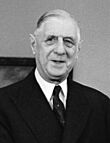 |
Charles de Gaulle | 8 January 1959 | 28 April 1969 | Union for the New Republic |
| — | 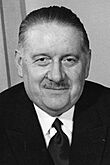 |
Alain Poher Acting |
28 April 1969 | 20 June 1969 | Democratic Centre |
| 19 |  |
Georges Pompidou | 20 June 1969 | 2 April 1974† | Union of Democrats for the Republic |
| — | 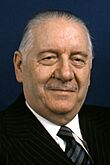 |
Alain Poher Acting |
2 April 1974 | 27 May 1974 | Democratic Centre |
| 20 |  |
Valéry Giscard d'Estaing | 27 May 1974 | 21 May 1981 | Independent Republicans |
| 21 | 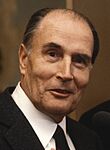 |
François Mitterrand | 21 May 1981 | 17 May 1995 | Socialist Party |
| 22 | 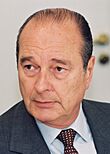 |
Jacques Chirac | 17 May 1995 | 16 May 2007 | Rally for the Republic |
| 23 |  |
Nicolas Sarkozy | 16 May 2007 | 15 May 2012 | Union for a Popular Movement |
| 24 | 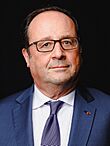 |
François Hollande | 15 May 2012 | 14 May 2017 | Socialist Party |
| 25 | 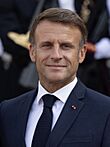 |
Emmanuel Macron | 14 May 2017 | Incumbent | La République En Marche! |
Timeline of Presidents
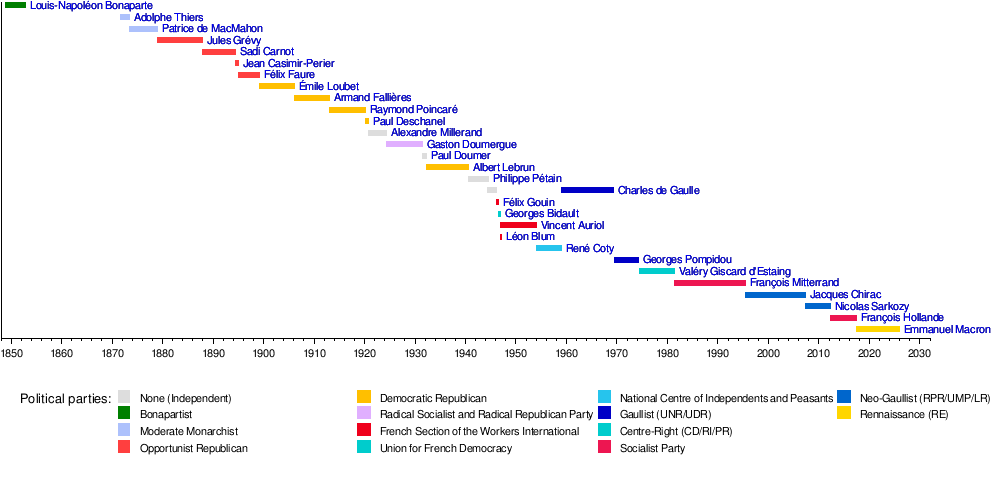
See also
- List of presidents of France by tenure
- List of prime ministers of France
Images for kids
de:Liste der Staatsoberhäupter Frankreichs#Zweite Republik






















